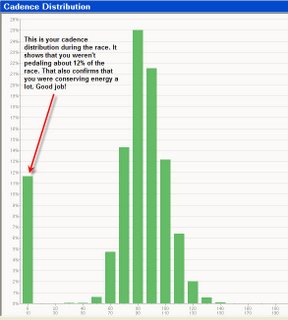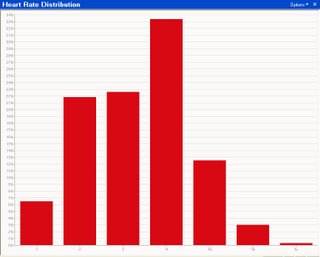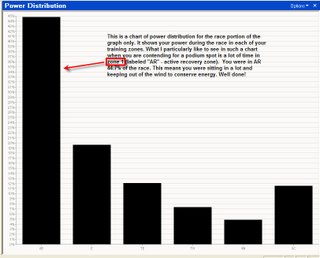Conserving Energy in Bicycle Road Racing
One of the road cyclists I coach used to ride a bit too aggressively for someone who was contending for a spot on the podium. He was too apt to go to the front and pull everyone even when there were no teammates to rely on. Coming from a triathlon and running background he saw bike races as mano a mano contests of who could work the hardest and be the last one standing. It’s seldom that way, however, for those who covet a high placement. When riding without team support one must be very conservative in the expenditure of energy.
Success in bike road racing is to a great extent being ready for brief episodes lasting just a handful seconds or a couple of minutes at most that ultimately determine the race outcome – breaks, hills, cross winds and sprints. One must be ready for these by having plenty of matches left to burn. If all of the matches are used up just pulling everyone around the course then the rider is toast by the time a key episode occurs and can’t respond.
He and I have talked about this a lot and I’ve used his power files to reinforce my suggestions to better take advantage of race situations. A race this past weekend confirms that he has it down pat now. The first chart here (“Cadence Distribution”) shows his cadence in 10-rpm bars. Note that the 0-10 rpm bar indicates that he wasn’t pedaling (or only soft pedaling) about 12% of the race. That’s pretty good but not conclusive evidence that he is conserving energy.
You also can’t tell what he was doing as far as conserving energy when you look at his “Heart Rate Distribution” chart. Heart rate tends to stay high even when pedaling easily for short periods in races.
The third chart (“Power Distribution”), however, shows that for nearly 45% of the race he was in his power zone 1 – less than 55% of his FTP (functional threshold power – the rough equivalent of lactate/anaerobic threshold). He was obviously staying out of the wind. This is exactly what he needs to do to produce race results.
I know that some will call this “wheel sucking” and imply that it is some how unethical. But bike racing is basically chess on wheels. The key to success is outwitting the competition. Especially when racing alone one must be very cagey to have a chance against those with team support. Conserving energy is the first thing to master when racing – all the more so when unsupported.


5 Comments:
Joe,
It is definitely great tool for the flat races . The picture/distribution will be quite different for races with some hills and for crits.
I'm seeing AR in 45% +/-5 for flats and 35% +/-5 for hills.
@
Lebusque has reached the age of 42 without ever understanding Reilhan, for all his wheel-sucking, is more of a racer than he is, no matter how much he pulls.
Tim Krabbe, The Rider
How come a cyclist must train so hard with interval workouts throughout the build and peak periods, only to take it easy in races? Basically the races turn into easy workouts if you just sit behind someone. In distance running, interval workouts are hard and races are also hard. You cannot take it easy in a 10k distance running race but you can sitting behind someone in a bicycle road race. Shouldn't cyclist just do endurance workouts, unless they are training for a individual time-trials?
anon--I suspect you've never done a bike road race. I did running races for 25 years at all distances and triathlons for 15 years. None of these has ever been as painful with as much suffering as the bike road races I've done even when trying to sit in. The race is not steady state as in running. The effort goes from coasting to as hard as you can possibly go at irregular intervals. The races are determined by what happens in 2 minute episodes (climbs, cross wind, sprint set up). Even if sitting in you must cover such moves. In fact, these are the reason why the athlete sits in in the example I gave here. You can't appreciate how hard they are if you've never done one.
Joe,
Thanks for this article. Did my first road ride [tour de scottsdale -- kudos to you ;)] and it made lots of sense as the course had its flats, climbs, and descents. Even though I opted for sans HRM, I could easily tell by RPE where I was functioning, especially towards the climbs at the end of the course, and where to best conserve, refuel, try to get HR low and relaxed.
Mike
Post a Comment
<< Home